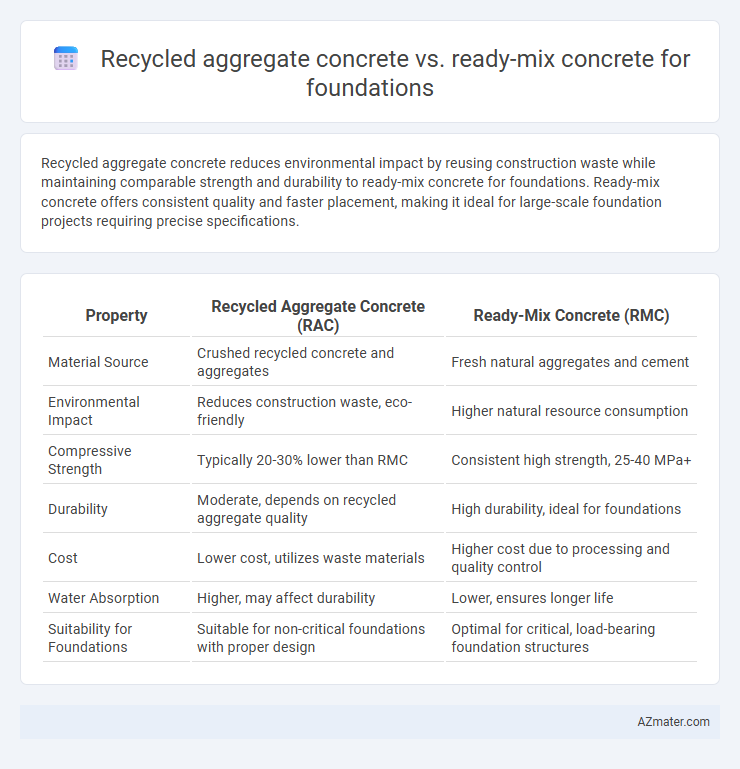Recycled aggregate concrete reduces environmental impact by reusing construction waste while maintaining comparable strength and durability to ready-mix concrete for foundations. Ready-mix concrete offers consistent quality and faster placement, making it ideal for large-scale foundation projects requiring precise specifications.
Table of Comparison
| Property | Recycled Aggregate Concrete (RAC) | Ready-Mix Concrete (RMC) |
|---|---|---|
| Material Source | Crushed recycled concrete and aggregates | Fresh natural aggregates and cement |
| Environmental Impact | Reduces construction waste, eco-friendly | Higher natural resource consumption |
| Compressive Strength | Typically 20-30% lower than RMC | Consistent high strength, 25-40 MPa+ |
| Durability | Moderate, depends on recycled aggregate quality | High durability, ideal for foundations |
| Cost | Lower cost, utilizes waste materials | Higher cost due to processing and quality control |
| Water Absorption | Higher, may affect durability | Lower, ensures longer life |
| Suitability for Foundations | Suitable for non-critical foundations with proper design | Optimal for critical, load-bearing foundation structures |
Introduction to Foundation Concrete Types
Recycled aggregate concrete (RAC) incorporates crushed demolition waste, offering sustainability benefits and reducing natural resource depletion compared to traditional ready-mix concrete (RMC). Ready-mix concrete, produced in batch plants with precise mixing ratios, ensures consistent quality for foundational structures requiring high strength and durability. Both types serve foundational purposes, with RAC favored for eco-friendly projects and RMC preferred for standardized performance and structural reliability.
Overview of Recycled Aggregate Concrete
Recycled Aggregate Concrete (RAC) incorporates crushed waste concrete as a substitute for natural aggregates, significantly reducing environmental impact and raw material consumption in foundation construction. Its properties, such as compressive strength and durability, are comparable to Ready-mix Concrete (RMC), but RAC offers enhanced sustainability by promoting circular economy practices in the construction industry. The use of recycled aggregates in concrete foundations supports LEED certification and reduces landfill waste, making it a viable and eco-friendly alternative to conventional ready-mix concrete.
Understanding Ready-Mix Concrete
Ready-mix concrete is a pre-mixed blend of cement, aggregates, water, and admixtures, delivered to the construction site in a fresh, plastic state, ensuring consistent quality and precise proportioning ideal for foundation work. Unlike recycled aggregate concrete, which incorporates crushed debris and recycled materials, ready-mix concrete offers enhanced durability, strength, and uniformity essential for foundational stability. The controlled production environment of ready-mix concrete minimizes variability, reduces on-site labor, and accelerates construction schedules in foundation projects.
Key Material Properties Comparison
Recycled aggregate concrete (RAC) exhibits lower compressive strength and higher water absorption compared to ready-mix concrete (RMC), impacting durability and structural integrity in foundation applications. RMC typically features consistent quality with optimized particle grading and lower porosity, enhancing load-bearing capacity and reducing shrinkage. The presence of residual mortar in RAC increases porosity and reduces density, which can affect long-term performance under heavy foundation loads.
Strength and Durability Performance
Recycled aggregate concrete exhibits slightly lower compressive strength compared to ready-mix concrete, but advancements in mixing techniques have improved its performance for foundation applications. Its durability is enhanced by careful selection and treatment of recycled aggregates, reducing permeability and resistance to freeze-thaw cycles. Ready-mix concrete typically offers superior consistency and higher initial strength, making it preferable for critical foundation structures requiring immediate load-bearing capacity.
Environmental Impact Assessment
Recycled aggregate concrete (RAC) significantly reduces landfill waste by incorporating processed construction debris, resulting in lower carbon emissions compared to traditional ready-mix concrete (RMC) used in foundations. Life cycle assessments reveal RAC's decreased extraction of virgin materials and reduced energy consumption, contributing to a smaller ecological footprint. While RMC offers consistent strength and workability, the environmental benefits of RAC make it a sustainable choice for foundation construction with proper mix design and quality control.
Cost Factors and Economic Viability
Recycled aggregate concrete (RAC) typically reduces material costs by utilizing waste aggregates, lowering expenses related to raw material extraction and transportation compared to ready-mix concrete (RMC). While RMC provides consistent quality and faster on-site application, its higher pricing stems from centralized batching plants and delivery logistics. Evaluating long-term economic viability favors RAC in sustainable projects due to cost savings and environmental benefits, but RMC remains preferred for projects prioritizing reliability and uniformity in foundation construction.
Construction Practices and Workability
Recycled aggregate concrete (RAC) requires careful mix design and moisture control to achieve consistent workability suitable for foundation applications, often necessitating admixtures to offset variability in recycled materials. Ready-mix concrete (RMC) provides superior uniformity and workability due to precise batching and quality control at the plant, facilitating faster placement and reduced labor on site. Construction practices for RAC involve stringent testing and gradual adjustment of mix proportions, while RMC enables efficient foundation pours with predictable strength development and minimal onsite modifications.
Regulatory Standards and Compliance
Recycled aggregate concrete (RAC) and ready-mix concrete (RMC) must adhere to specific regulatory standards such as ASTM C33 for aggregates and ASTM C94 for ready-mix delivery to ensure structural integrity in foundations. RAC requires compliance with additional environmental and sustainability guidelines including ISO 14001 and LEED certification criteria to promote eco-friendly construction practices. Both concrete types must meet local building codes and standards like ACI 318, ensuring safety and durability in foundation applications.
Selection Criteria for Foundation Applications
Recycled aggregate concrete offers environmental benefits and cost savings, but selection for foundation applications depends on factors like structural load requirements, durability, and local building codes. Ready-mix concrete provides consistent quality, higher compressive strength, and better control over mix proportions, making it suitable for foundations requiring precise engineering standards. Choosing between the two requires evaluating project-specific criteria such as soil conditions, foundation type, and sustainability goals to ensure optimal performance and compliance.

Infographic: Recycled aggregate concrete vs Ready-mix concrete for Foundation
 azmater.com
azmater.com